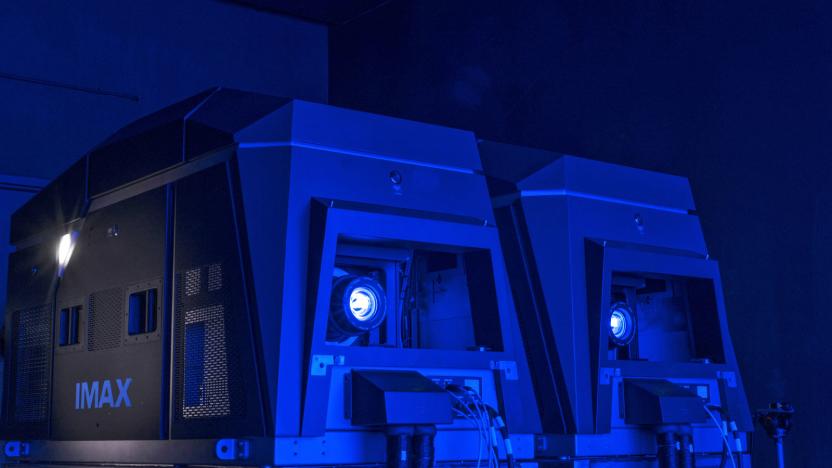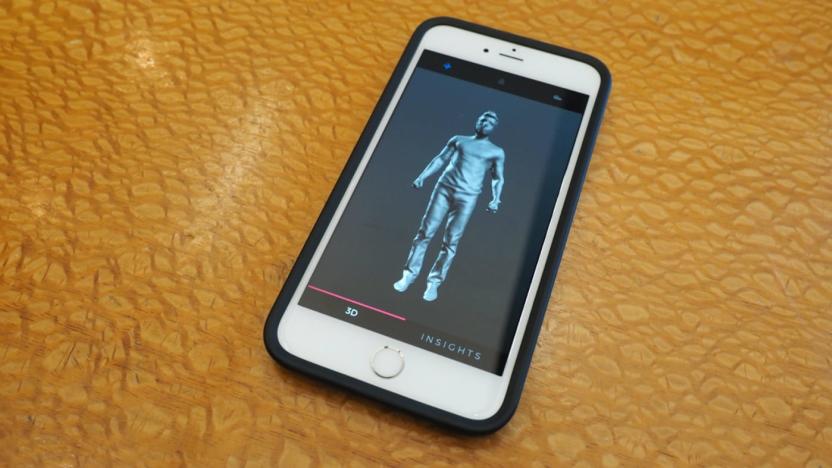laser
Latest

Look at this ridiculous 200-watt laser bazooka
YouTuber and insane laser electrician Styropyro has outdone himself once again. While his previous experiments have led to a homebuilt lightsaber and a dangerous laser shotgun, this time has more than added more than five times the power to create a massive, 200W "laser bazooka."

This laser-powered drum machine is a stunning work of art
We're big fans of homemade instruments, synthesizers and other noise makers here at Engadget. Russian artist Vtol created a massive laser-powered drum machine installation as part of Earth Lab, a joint project between the Polytechnic Museum Moscow and Ars Electronica Linz. Vtol describes the huge instrument as "an autonomous light-music installation," and it's certainly provides a neat visual to complement its noise making. The setup is officially called "Divider" and it uses seven lasers that pass through fans to send a light signal for generating sound. The laser beams are altered by high-speed fans with a photo sensor on the end monitoring the presence or absence of light.

ICYMI: Smart coats, robot whiskers and vaporizing lasers
Today on In Case You Missed It: Google and Levi's team up to make a smart Canadian Tuxedo jacket, the University of Bristol teaches a whiskered robot to react to stimuli and Stanford's Linear Accelerator fries water droplets with an X-ray laser, because science!

Terahertz laser tech could scan for bombs at airports
Terahertz spectrum scanning is potentially ideal for finding bombs due to the sheer range of materials it can detect, but it's not exactly practical for luggage checks when you need both a suitcase-sized machine and up to half an hour to conduct a scan. MIT researchers have a better way, though: they've developed a quantum cascade laser system that should make terahertz detection a reality. Since the laser's single, tiny frequency comb only consumes power for very brief periods, you can fit it into a part the size of a chip without a gigantic cooling unit -- perfect for airport scanners. It takes as few as 100 microseconds to identify a substance, too, so you wouldn't have to wait (longer than usual, anyway) while agents scan your bags.

IMAX's laser projectors are worth the pricier ticket
I'm no fan of movie theater gimmicks. 3D glasses, giant screens, 4D "sensory experiences," food and drink service have simply never been worth the added ticket prices for me. That was, at least, until I sat down to watch Captain America: Civil War on IMAX's newest 3D laser projector system.

ICYMI: Facebook VR selfies, laser-powered water and more
#fivemin-widget-blogsmith-image-35216{display:none;} .cke_show_borders #fivemin-widget-blogsmith-image-35216, #postcontentcontainer #fivemin-widget-blogsmith-image-35216{width:570px;display:block;} try{document.getElementById("fivemin-widget-blogsmith-image-35216").style.display="none";}catch(e){}Today on In Case You Missed It: Facebook is adding VR to the social network and one of the new tricks will let users take a selfie of their avatar selves inside of different tourist spots. Japanese researchers discovered that a water droplet coating allowed water to be controlled by a laser, capable of pulling 150 times its mass when harnessed like a mini oxen. Finally, a backpack on Kickstarter would charge your devices on the move and roughly nine other things. Guinness World Record fans will want to see this crazy long K'NEX contraption. As always, please share any great tech or science videos you find by using the #ICYMI hashtag on Twitter for @mskerryd.

Smart mirror scale measures your volume as well as your weight
Guess what fitness startup Naked Labs wants you to do. The company today debuted its first product: a smart scale system that scans users with lasers, enabling them to track their fitness goals in three dimensions. The $500 system is designed for in-home use and is comprised of three parts: the scale itself, which doubles as a turntable; a full-length mirror outfitted with Intel RealSense depth sensors and the "Naked" mobile app. To initiate a scan, users first stand on the scale in their skivvies. It will begin to rotate as the mirror measures their body volume and sends that information to the associated app. The entire process takes about a minute.

'Starshot' plan gets probes to Alpha Centauri in your lifetime
The concept of exploring other star systems with probes (and not just telescopes) has proven elusive for one good reason: even the fastest spacecraft would take 30,000 years just to reach Alpha Centauri, our closest neighboring star. However, investor and space project enthusiast Yuri Milner thinks it's possible to do better. He and physicist Stephen Hawking have launched Breakthrough Starshot, a $100 million program that aims to get probes to Alpha Centauri within a generation. If all goes well, the observers would reach the relatively close-by system (4.4 light years away) within 20 years of leaving Earth.

Scientists use lasers to sniff out E. coli on food
Scientists have developed a better sniff test for that plate of leftovers that's been hanging out in your fridge. Researchers from the Korea Advanced Institutes of Science and Technology are using lasers (the jury is out on whether they're of the "friggin'" variety or not) to determine just how much bacteria is crawling all over your stored food. MIT Technology Review says that by shooting a red, coherent laser at chicken breast coated with E. coli and Bacillus cereus, the Korean scientists were able to detect changes in laser refractions, indicating the bacteria's presence.

London theatre shines lasers at audiences to deter phone use
In a bid to stop audiences from distracting actors on stage, staff at a London theatre are shining lasers at audience members who won't turn off their smartphone. The Times reports that Jermyn Street Theatre, a small auditorium in the West End, adopted the practice after hearing reports of its success inside the Shanghai Grand Theatre and Beijing's National Centre for the Performing Arts in China.

ICYMI: A real hoverboard for 20K, the worm robot and more
#fivemin-widget-blogsmith-image-511213{display:none;} .cke_show_borders #fivemin-widget-blogsmith-image-511213, #postcontentcontainer #fivemin-widget-blogsmith-image-511213{width:570px;display:block;}try{document.getElementById("fivemin-widget-blogsmith-image-511213").style.display="none";}catch(e){}Today on In Case You Missed It: Scientists have built a robot that is controlled by software directly modeled on a worm's brain, near cyborg-style. ARCA has built a hoverboard they say can actually hover above ground for up to six minutes and is being sold for $20,000. Meanwhile the U.S. Marines are discharging a robot for being a bit too loud for stealthy applications: The LS3 is being put out to pasture.

Homemade laser lightsaber is as risky as it looks
It's clear that there are a lot of Star Wars fans these days, but one of them just took that adoration to a decidedly geeky new level. Styropyro (he of laser shotgun fame) has built a lightsaber using a heavily upgraded 7W blue laser -- it's several times more powerful than what's needed to blind someone. While the beam isn't contained like the "real" thing, it's strong enough that it can burn through wire and other household objects. You probably don't want to build this at home unless you're exceptionally careful, then.

London's entire Boris bike fleet will soon have laser lights
Boris bikes have never been London's trendiest form of public transportation, although they picked up some much-needed style points earlier this year thanks to a laser-projected light system. At the time it was limited to 250 two-wheelers, but today Transport for London (TfL) has announced the trial will be expanded to all 11,500 Santander bicycles in early 2016. The Blaze Laserlight projects a green version of the standard cyclist symbol six meters in front of the rider, making them visible to pedestrians and traffic looking to pull out up ahead.

Everything you know is wrong: lasers are cooling things now
A group of scientists at the University of Washington were able to successfully refrigerate water using an infrared laser. This is a big deal because researchers weren't even sure this was possible as water tends to heat up when illuminated. However, by using an infrared laser and nanocrystal, it surprisingly created the opposite effect, which is a world first. The team of scientists were able to cool liquid water by 36 degrees Fahrenheit (20 degrees Celsius). The crystal absorbed the light's photons and then when the photons were released, they had a higher energy value compared to when they first entered. These photons then scattered and carried away heat, cooling the surrounding water.

Scientists want to laser-heat stuff to ten million degrees
Researchers at Imperial College London believe that they've created a method that could prove critical in the search for unlimited clean energy. The team has produced a theoretical method that, at least on paper, is capable of super-heating an object to ten million degrees in a fraction of a second. It's hoped that technology like this, if proven in the real world, will form a key component of a fusion reactor that'll provide a warm light for all mankind.

The Big Picture: The world's most powerful x-ray laser
This is a photo of the Linac Coherent Light Source or LCLS -- an x-ray free-electron laser in Stanford University's SLAC National Accelerator Laboratory. It's also dubbed as the most powerful x-ray laser in the world. The SLAC Lab took a group of amateur and pro photographers on a tour of its facilities, giving them the chance to shoot photos of both the LCLS and the Stanford Synchrotron Radiation Lightsource (SSRL) for a contest. This image captured by Nathan Taylor is one of the top three entries taken by people from the group and will be submitted to this year's Global Physics Photowalk, which aims to show behind-the-scenes photographs of the world's leading particle physics laboratories. You can see all the winners, including another winning picture by Daniele Fanelli that features toy dinosaurs, along with the other entries that got honorable mention on SLAC's website. [Image credit: SLAC National Accelerator Laboratory/Nathan Taylor]

Watch this graphene paper slither around like it's alive
Researchers from China have taken shape-memory materials to a creepy new level with a self-folding paper that can propel itself by "walking." Sorcery? Not quite. It's actually made from everybody's favorite wonder-material, graphene, and heated by an infrared laser that causes active regions to contract, then expand when it shuts off. By placing the regions in strategic locations, the team can make the paper move in any direction. It isn't going to put a scare into Sarah Connor just yet, but the team thinks it could one day be used to create contracting "muscles" that do power murderous 'bots. In the near term, the material could lead to low-cost temperature and humidity sensors.

Researchers control fruit flies' hearts with a laser
Scientists have directly controlled animals before, but these approaches tend to either require surgery or only work with critters at certain stages in their lives. Researchers might have a more powerful technique in store, however: they've managed to control fruit flies' heartbeats through laser pulses. The approach relies on optogenetics, or modifying the genes of animals to produce materials that respond to light. In this case, the team tweaked flies' heart cells to produce light-sensitive proteins. After that, it was just a matter of zapping the hearts to make them beat on command, whether the flies were larvae or full-grown insects.

London's Boris bikes kitted out with lasers in the name of safety
If there's one universal truth, it's that everything is better with lasers: sharks, dinosaurs, Facebook, and now... Boris bikes. Under a new safety trial, Transport for London has fitted 250 of the capital's pushbikes-for-hire with a laser-projection system that beams the familiar stickman bicycle logo onto the ground ahead of the cyclist. With a six metre lead on the rider, the projection is intended to alert motorists to the close presence of the cyclist, who could be cruising in the driver's blind spot at the time. In early tests, the laser projection was said to improve the nighttime visibility of bikers when compared with the regular LED headlamps currently in use. The tech itself is being provided by UK upstart Blaze, which already sells the Laserlight as a handlebar add-on for any bicycle. Should the 10-or-so week trial be deemed successful, the plan is to retrofit all 11,500 Boris bikes with the dynamo-driven projection system.

Self-driving cars can be fooled by fake signals
You'd think that self-driving cars would be most vulnerable to remote hacks, but the biggest danger may come from someone nearby with a handful of cheap electronics. Security researcher Jonathan Petit has determined that you can fool LIDAR (the laser ranging common on autonomous vehicles) by sending "echoes" of fake cars and other objects through laser pulses. All you need is a low-power laser, a basic computing device (an Arduino kit or Raspberry Pi is enough) and the right timing -- you don't even need good aim. Petit managed to spoof objects from as far as 330 feet away in his proof-of-concept attack, and he notes that it's possible to present multiple copies of these imaginary objects or make them move. In other words, it'd only take one prankster to make a self-driving car swerve or stop to avoid a non-existent threat.











